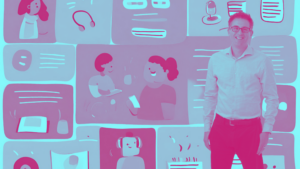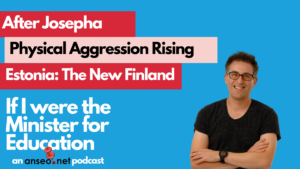Whatever some people say, I still believe children have great imaginations. When I was in school, certainly once infants was out of the way, there were few ways for me to express my imagination – the weekly essay chosen by my teacher was possibly my only avenue in a classroom of fact-learning. The yard was, and still is, the place where children’s imaginations are free. When I’m on yard duty, I meet puppies playing with superheroes and watch chasing games with elaborate rules and consequences. Really, not much has changed except for the possibilities in the classroom.
Last term I started a project with 20 pupils in 5th and 6th class. Their job was to set up a film studio and create a cartoon. My job was to make sure that there was scaffolding in place to ensure the project maintained focus. The plan is to have the children ready to publish their cartoon by St. Patrick’s Day. So far, we have set up groups and children have been busy with the following skills:
 Brainstorming: Children had to come up with a name for their production company and then a topic for their cartoon. This transformed into an “Apprentice”-style discussion about names that would suit their personalities and the fact that they were creating a cartoon. It was interesting to see how personalities, gender and YouTube had major impacts on their choices. I was delighted with one group when I saw a wonderfully original name for their company only to be informed that the pupil in question had simply ripped it off a YouTube video he liked! In fact, it was interesting that most of the groups started their process with something familiar and tweaked it into something original.
Brainstorming: Children had to come up with a name for their production company and then a topic for their cartoon. This transformed into an “Apprentice”-style discussion about names that would suit their personalities and the fact that they were creating a cartoon. It was interesting to see how personalities, gender and YouTube had major impacts on their choices. I was delighted with one group when I saw a wonderfully original name for their company only to be informed that the pupil in question had simply ripped it off a YouTube video he liked! In fact, it was interesting that most of the groups started their process with something familiar and tweaked it into something original.
The topic of the cartoon was something similar. One of the criteria was that the cartoon could only have a maximum of three characters. This disappointed one of the children who was hoping to set an army of soldiers against another army of aliens in his idea. However, having one simple condition, really challenged their thinking.
Design/Personalise: The next step was for children to design the logo for their production company. The goal was to try and link the name of the company within the design. Considering the number of logos that children are exposed to on a regular basis, I was surprised by their general lack of knowledge. My assumption that they would find a task like this easy didn’t work and we are going to look at this in our first lesson when we come back to school this week.
Which leads nicely to:
Evaluation: Our next lesson will be on logos. I’m going to give the children lots of logos – some famous and others not so famous. I’m not an expert in logo design but we’re going to examine some simple theory.
From this, we can look at fonts, colours, shapes and evaluate these in terms of emotions and effectiveness. We’re going to evaluate whether the logos are effective and why this is. We’re going to try and understand why choices were made. We’re then going to discuss a fictional company and make decisions around ideas for a logo. Finally, we’ll go back to the drawing board for designing their logos.
 Preparation of Tools: Before we get planning, I want to get the children to see the tools that they’ll be using. Whenever I design a piece of software, I try and find the tool that suits best for my needs. For example, back when I programmed the game, “Who Took the Book?”, a game which essentially was a sequence of puzzles, the tool Opus Illuminatus suited my needs. However, it would be useless to create an iPhone app so I use other tools for this. I want to present children with a number of animation tools and let them decide which one they are comfortable using.
Preparation of Tools: Before we get planning, I want to get the children to see the tools that they’ll be using. Whenever I design a piece of software, I try and find the tool that suits best for my needs. For example, back when I programmed the game, “Who Took the Book?”, a game which essentially was a sequence of puzzles, the tool Opus Illuminatus suited my needs. However, it would be useless to create an iPhone app so I use other tools for this. I want to present children with a number of animation tools and let them decide which one they are comfortable using.
The HP Teacher Exchange blog has come up with 7 Web 2.0 animation tools ranging in simplicity and power, which I think will give the children a good choice. I’m going to give them time to play around with these tools and see what they can do with them. They will have to work as a team to evaluate them and I will provide them with a template to do this.
 Planning: With all our evaluations done, it’s time to start planning our story. The children have up to 2 minutes to tell their full story. They need a plan. That’s where I’m going to flip down our laptops and get the pencils, erasers and paper out. I feel that one can easily tell a simple short story in 8 “bits” to give them time for an introduction (2), development (2), problem (2) then conclusion (2). Obviously there’s flexibility to this but it’s not a bad guideline. The group will have to draw their story including the setting, characters, dialogue, etc. Once the storyboard is complete, they are ready for the next part.
Planning: With all our evaluations done, it’s time to start planning our story. The children have up to 2 minutes to tell their full story. They need a plan. That’s where I’m going to flip down our laptops and get the pencils, erasers and paper out. I feel that one can easily tell a simple short story in 8 “bits” to give them time for an introduction (2), development (2), problem (2) then conclusion (2). Obviously there’s flexibility to this but it’s not a bad guideline. The group will have to draw their story including the setting, characters, dialogue, etc. Once the storyboard is complete, they are ready for the next part.
 Creation: I often find once all the idea stuff is out of the way, almost all the work is done. It’s time to use their chosen animation tool to create their cartoon. If the animation tool allows it, they will need to insert their company name, logo and title. After that, they need to put their storyboard in action.
Creation: I often find once all the idea stuff is out of the way, almost all the work is done. It’s time to use their chosen animation tool to create their cartoon. If the animation tool allows it, they will need to insert their company name, logo and title. After that, they need to put their storyboard in action.
This process can take the majority of the time and progress can be slow but it is great to see all the discussion, decisions and learning that can come from it. Once all this is done, it’s time for the final part.
Presentation: All the hard work is done so it’s time to sit back and revel in all the hard work that has gone on before. All the decisions, evaluations, discussions, problem-solving and every other skill come down to this moment… and we will celebrate! We will certainly be showing the cartoons to each other as a group. The students will decide whether they merit a premiere for the rest of the school and the parents.
Will we have covered the curriculum? Of course. Literacy is easy to see here. In fact, if this were simply just a plan for the English curriculum, I’d be happy. However, there are other skills at play here, which have been outlined and fall into lots of subjects:
- Drama
- Maths
- Geography
- SPHE
- Visual Arts
- History
- Music (if they need a soundtrack)
- Learn Together (for ET schools)
There are possibilities that other subjects will be covered depending on the topic of the cartoon. It’s not impossible that the lessons learned in Alive O, (the Catholic Religion Programme), will be mirrored in any stories with morals.
If the children allow me, we’ll hopefully be able to publish their cartoon for everyone to see. My hope is that most of them will be proud of their work and this will be easy but 11-13 year olds think differently to me and that’s an important lesson I’ve learned.
Images from Creative Commons
- Imagination:
 Some rights reserved by Sarah&theSpider
Some rights reserved by Sarah&theSpider - Storyboard:

 Some rights reserved by mrmayo
Some rights reserved by mrmayo - Child with Animation Program:

 Some rights reserved by crol373
Some rights reserved by crol373 - Brainstorm:


 Some rights reserved by Coloriamo la cittÃ
Some rights reserved by Coloriamo la cittÃ




0 thoughts on “Imagination through Animation”
I actually enjoyed reading this post because your approach in learning is very dynamic, interactive and does trigger your student’s imagination. At such a young age, you exposed them to think outside the box and to be more creative in creating their concepts.